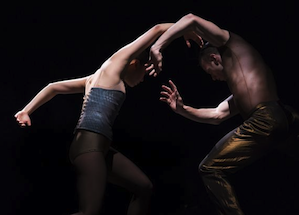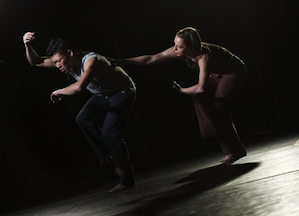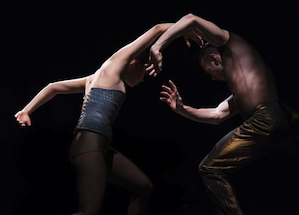
Photos by Paula Lobo
There are many dance troupes whose rosters are full of artists with great credentials from diverse training grounds. Cedar Lake Contemporary Ballet is the terpsichorean equivalent of Harvard. It’s rare, however, to see dancers perform not only gorgeously but with such seamless unity. Aside from noting its depth and breadth, sensing that confidence and security added to the delight of Saturday night’s show, presented by Cal Performances. Although with the departure of Benoit-Swan Pouffer just after its New York home season the company suddenly found itself without an artistic director, clearly its ballet mistress since 2005, Alexandra Damiani, is doing a fine job of filling in.
The offerings during this brief visit were as wide-ranging and as accomplished as the dancers’ backgrounds. Jiri Kylian’s Indigo Rose (1998) showcased virtuosic combinations of accelerating speed leavened with sharp wit and stunning stagecraft. Crystal Pite’s Ten Duets on a Theme of Rescue (2008) blurred the lines between duets, trios, dependence, and initiative, making of its similarities differences an intimate totality. And Jo Stromgren’s Necessity Again was a real mother of invention, drawing upon European dance theater influences and tweaking deconstructionism with a cheery vengeance.
Indigo Rose feels like a collage. The music ranges from John Cage and Robert Ashley to Francois Couperin and J.S. Bach. The explorations send dancers into plushy plié-accented duos and juxtaposes two couples, one quietly fluid, the other investigating brute force. Another scene deploys a white curtain across the stage, a slashing brightly lit diagonal focusing attention on a soloist in indigo blue tights with arrow-sharp acceleration to match his surround. It’s the start of a game of light and shadows; a man-woman pas de deux is transformed into silhouette; the woman towering above the man, the interplay growing as her legs surround him into something risqué. Then everything turns reflective, and there’s the balm of a minuet. We seem to be swinging in some wide historical arc, but we aren’t fully invested in either past or present.

Is there a narrative arc to the dance? Up to you, as you watch black and white films of dancers on a screen in close-up, faces and features sliding into horizontal strips, apart, together, apart, and so on. There’s also a topless woman who seems to stay in one piece, but why she’s there and why she looks happy — she seems very naked next to the guys, but maybe in Europe this is no biggie — will have to remain a mystery.
In Canadian dancemaker Crystal Pite’s Ten Duets …, the five dancers are also crew, moving large lights on and off the stage. The lighting (designed by Jim French) evokes cinema, and the mellow luminescence invests the proceedings with a sense of enclosure, so that which is projected forward — the moves of the dancers — also seems rather private, the audience as invited guests. Not that all is quiet by any means. There are violent throws and runs and dancers take liberties with each others’ necks, turning them with a familiarity that seems unthinkable, considering the vulnerability of that part of the body. Complementary to this is a kind of cooperative shielding and compassion, rendered more personal by the lighting. This was my first experience of Crystal Pite, who also has her own company, the wonderfully named Kidd Pivot. Hopefully it won’t be the last.
Norwegian Jo Stromgen’s Necessity, Again plays with and against what he calls “the necessity to formulate everything in words.” Why can’t we just dance? Stromgen argues, putting the 10 dancers onstage with desks, files, and reams and reams of paper. The sense of being crushed by messages grows ever stronger with the arrival of more, all of It seeming to have writing on it that the cast, dressed office-style, attempts to decipher, or clothespins to lines that cross the stage.
Lush movement competes with a cacophony of academic gobbledygook on recording, and the dancers topple over stuporously, or lipsynch, much the losers in this war of the words. Even what passes here for sensuality — a seeming inspection of a woman’s naked lower half — leads only to confusion (and a certain revulsion at this interlude of creepy Mad Men Modern). The deadpan dancing to schmaltzy Charles Aznavour tunes evokes the entire history of cynical postwar society, but in this context it touches particularly strongly on the systematic over-intellectualization of dance as a field of study. The dancers get some of their own back at the end, playing jump rope with the clotheslines — although the messages attached to them remain securely in place.

